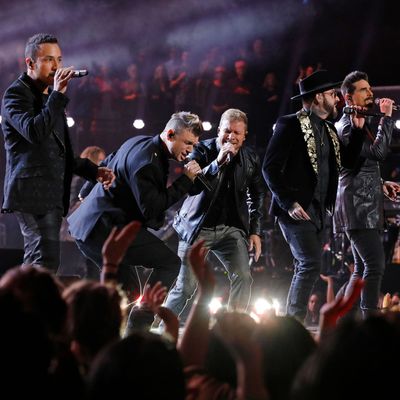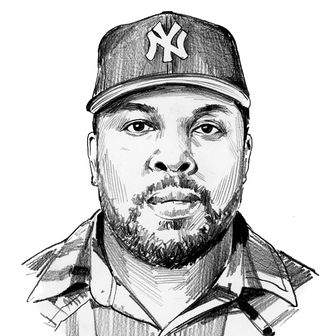
Pop fandom can be warfare. Rivalries and chart battles require you to pick a side, to “get off the fence” and throw your support behind a winner. These wars have been raging for decades. In the ’60s, it was the Beatles versus the Stones. In the ’70s, it was punk rock versus dinosaur rock and mainstream rock versus disco. In 1999, it was ‘N Sync versus the Backstreet Boys, Limp Bizkit and Korn versus every working teen pop star, and Eminem versus all the above and more. The pop squabbles of the last year resemble this era the closest; we haven’t spent this much time discussing Eminem, Justin Timberlake, and the Backstreet Boys since the three parties vied for top billing on TRL in its heyday. The triumphant return of the Backstreet Boys in the wake of this month’s new album DNA — which sold nearly a quarter million pure albums in its first week out, trouncing the turnout in the same space for the group’s last three studio albums — is a good opportunity to parse what the boys brought to the table in the first place and why they appear to be resonating more with fans this year than they have in the last decade.
Critically speaking, ’90s teen pop got a raw deal, as it arrived ten years too late to enjoy the brash arrangements and bratty attitude of the ’80s class and ten years too early to meet the enthusiastic new class of dance-music fans that greeted the ascendant early Katy Perry and Lady Gaga singles. When disgraced boy-band Svengali Lou Pearlman took interest in replicating the success of the ’80s Boston rival R&B acts New Kids on the Block and New Edition, he sent his fledgling groups to Sweden, because the audience didn’t exist in their home country yet. The dance music bubbling on the charts in Europe was just beginning to touch America — if you were old enough to be obsessed with music in 1994, there is a strong chance that you still know the words to several Ace of Base singles — but the charts in the States were still working through the nihilist urges of the grunge movement, the marital sentimentality of country megastars like Garth Brooks, and the inner-city fatalism of gangsta rap. It took a few years for the cheery dance-pop brewing at Stockholm’s Cheiron Studios to reach the U.S., but when it did, acts who worked with Pearlman in some fashion — Backstreet, ‘N Sync, Britney Spears — rode the crest of the wave.
Cheiron’s aces were the producers Max Martin and the late Denniz Pop, gifted music scribes Backstreet’s A.J. McLean once described as looking like they were “plucked out of Metallica.” You can hear Pop and Martin’s signature on the early Robyn smash “Show Me Love.” The track blends hip-hop and R&B drums and syncopation with candy-sweet melodic flourishes and liberal use of synthetic orchestra hits, positing pop as the median sound between the other genres dominating the charts at the time. (Max Martin’s ingenuity on this front has endured in the 20 years since, as has his career as pop’s go-to hit-maker.) To listeners old enough to have crushes but too young to be cynical about pop music as packaged product, this stuff was catnip. To people who grouse about “real” instruments and commerce as the enemy of good art, it was reviled. It’s a shame, because the music Pop, Martin, and the ’90s teen pop icons made in the first few years was undeniably solid on a structural level, regardless of how deeply mawkish the lyrics could be. (Get me drunk enough, and I’ll identify the first five seconds of the video edit of Britney’s “Crazy” as one of the most frenzied moments in modern music, and while we’re on the subject of Martin’s cracked early genius, Millennium’s “Don’t Want You Back” sounds like robots of the future discovering salsa.)
At their best, the Backstreet Boys were a sharp singing group bolstered by the precision of a newly minted pop-music juggernaut. The hits were inescapable. The mid-tempo deep cuts were fascinating experiments. The ballads were sturdy but a touch too drippy. If you could get past the sterile cleanliness of the enterprise, there were hummable tunes for days. The boys lost the plot when they took time off after 2001’s Black and Blue and came back older, wiser, and backed by live instruments on 2005’s Never Gone. They’d reached the point in every boy-band journey where the gap between the age of the group and the age of its following starts to matter, when fans clamor for more of what came before, but the group gets tired of playing the same stuff every night on tour. The Backstreet Boys were pushing it, selling pop rock and 30-something maturity on a fandom still in its early 20s (although it’s worth noting that the windswept lead single “Incomplete” is one of their finest slow songs). Meanwhile, Justin and Britney’s hit parade produced an army of racy hip-hop and dance-pop hits. The squeaky-clean bit was old hat. “Nobody loves a man group,” rock scribe Robert Christgau wrote of the turning tide in 2005. A year later, singer Kevin Richardson left to pursue an acting career. The group soldiered on. The fandom hesitated.
Getting the Backstreet Boys back in shipshape was a game of giving the people exactly what they wanted. First, they dove full bore into the nostalgia circuit. In 2010, Backstreet teamed up with New Kids on the Block to form NKOTBSB, a supergroup that built a successful worldwide arena tour on a round-robin set list that culminated each night with an outrageous medley of “Everybody (Backstreet’s Back)” and “Hangin’ Tough.” Kevin Richardson rejoined the group in 2012 as the yearlong NKOTBSB trek came to a close. 2013’s In a World Like This was a slight return to form and a celebration of the group’s 20th anniversary, but it wasn’t until the run of singles for this year’s DNA that they realized that pop music had cycled back around to the brand of slippery kitchen-sink dance music that built them in the first place that the Backstreet Boys’ luck on the Hot 100 changed. Last year’s “Don’t Go Breaking My Heart” is a no-brainer: Give a group that built its reputation on slick, slight EDM tunes the slickest, slightest EDM tune and watch sparks fly. But the success of DNA is more than a story of cyclical trends in popular music.
The Backstreet Boys toured consistently enough to stay afloat and also keep their base excited. Then they got to work seeking out the best writers and producers in the biz. DNA’s moody guitar ballad “Chances” soars on assists from Shawn Mendes and OneRepublic’s Ryan Tedder. Elsewhere, there’s help from R&B hired hands Kuk Harrell and the Stereotypes. Stuart Crichton — a Scottish writer and producer with a 25-year track record of success with everyone from the Pet Shop Boys to Kesha — got involved with the project on a lark, when he took a friend to Las Vegas, and the pair visited the Backstreet Boys’ Planet Hollywood residency Larger Than Life with the intention of meeting the group to gift them the music that would become the new album’s lead single. Crichton’s five co-writes are the meat of DNA, a breezy collection of three-minute love songs that apply the singers’ airtight melodies to the sound of modern pop radio. “OK,” “Chateau” and “The Way It Was” acknowledge the group’s maturity while revisiting the same feelings of jittery new attraction that hooked fans in the ’90s. DNA’s a best-case scenario for a name thought to be finished over a decade ago, a careful balance of necessary modernization and embrace of the group’s boy-band legacy.
But DNA’s not No. 1 in the country right now because the singles are smashes or because hundreds of millions of people are streaming the record. (“Don’t Go Breaking My Heart” peaked respectably at No. 63 on the Hot 100. “Chances” hasn’t had the same luck. Only 7,000 of the 234,000 equivalent sales DNA accumulated in its first week out came from streams. Billboard counts 1,500 streams as one equivalent unit. You do the math.) Tickets for the DNA World Tour, which kicks off in May not long after Larger Than Life wraps, were sold in bundles that included a copy of the album. Target is selling an exclusive shirt that comes with the CD. DNA moved over 200,000 units in pure sales last week thanks in part to the Billboard policy allowing albums bundled with merch and tickets to be reported as sales, so long as the music is valued at no less than $3.49. DNA succeeded because the Backstreet Boys maintained a relationship with fans through the lean years, then found a way to turn a still-massive base into representation on the charts. DNA’s chart windfall dovetails with the sense that chart placement is a better gauge of who’s interested in an artist now than who’s shelling out money for a new album. It isn’t a vote of confidence in the Backstreet Boys as an entity still pushing the dial on mainstream music, especially not after a summer where a member of the girl group Dream came forward accusing Nick Carter of sexual assault. It is a reminder that a lot of people still love the music they grew up with. Nostalgia’s a powerful force.





